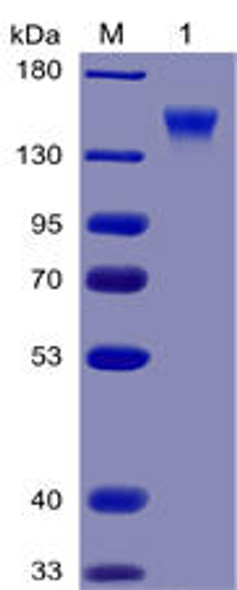CD Antigens Recombinant Proteins
Human CD96 Recombinant Protein (RPPB3103)
- SKU:
- RPPB3103
- Product Type:
- Recombinant Protein
- Species:
- Human
- Uniprot:
- P40200
- Research Area:
- CD Antigens
Description
| Product Name: | Human CD96 Recombinant Protein |
| Product Code: | RPPB3103 |
| Size: | 10µg |
| Species: | Human |
| Target: | CD96 |
| Synonyms: | CD96 Molecule, T Cell-Activated Increased Late Expression Protein, Cell Surface Antigen CD96, CD96 Antigen, T Cell Activation, Increased Late Expression, T-Cell Surface Protein Tactile, TACTILE. |
| Source: | Sf9 Insect cells |
| Physical Appearance: | Sterile filtered colorless solution. |
| Formulation: | CD96 protein solution (0.5mg/ml) contains Phosphate Buffered Saline (pH 7.4) and 10% glycerol. |
| Stability: | Store at 4°C if entire vial will be used within 2-4 weeks. Store, frozen at -20°C for longer periods of time. For long term storage it is recommended to add a carrier protein (0.1% HSA or BSA).Avoid multiple freeze-thaw cycles. |
| Purity: | Greater than 90.0% as determined by SDS-PAGE. |
| Amino Acid Sequence: | VWEKTVNTEE NVYATLGSDV NLTCQTQTVG FFVQMQWSKV TNKIDLIAVY HPQYGFYCAY GRPCESLVTF TETPENGSKW TLHLRNMSCS VSGRYECMLV LYPEGIQTKI YNLLIQTHVT ADEWNSNHTI EIEINQTLEI PCFQNSSSKI SSEFTYAWSV EDNGTQETLI SQNHLISNST LLKDRVKLGT DYRLHLSPVQ IFDDGRKFSC HIRVGPNKIL RSSTTVKVFA KPEIPVIVEN NSTDVLVERR FTCLLKNVFP KANITWFIDG SFLHDEKEGI YITNEERKGK DGFLELKSVL TRVHSNKPAQ SDNLTIWCMA LSPVPGNKVW NISSEKITFL LGSEISSTDP PLSVTESTLD TQPSPASSVS PARYPATSSV TLVDVSALRP NTTPQPSNSS MTTRGFNYPW TSSGTDTKKS VSRIPSETYS SSPSGAGSTL HDNVFTSTAR AFSEVPTTAN GSTKTNHVHI TGIVVNKPKD GMLEHHHHHH |
CD96 is a type I membrane protein which is a part of the immunoglobulin superfamily. CD96 functions as cell markers in immune-phynotyping and participates in antigen presentation. CD96 plays a role in the adhesive interactions of activated T and NK cells through the late phase of the immune response.�
CD96 Human Recombinant produced in Sf9 Baculovirus cells is a single, glycosylated polypeptide chain containing 490 amino acids (22-503a.a.) and having a molecular mass of 54.6kDa (Molecular size on SDS-PAGE will appear at approximately 70-100kDa).CD96 is expressed with an 8 amino acids His tag at C-Terminus and purified by proprietary chromatographic techniques.
| UniProt Protein Function: | CD96: May be involved in adhesive interactions of activated T and NK cells during the late phase of the immune response. Promotes NK cell-target adhesion by interacting with PVR present on target cells. May function at a time after T and NK cells have penetrated the endothelium using integrins and selectins, when they are actively engaging diseased cells and moving within areas of inflammation. Defects in CD96 are a cause of C syndrome (CSYN); also called Opitz trigonocephaly syndrome. This syndrome is characterized by trigonocephaly and associated anomalies, such as unusual facies, wide alveolar ridges, multiple buccal frenula, limb defects, visceral anomalies, redundant skin, psychomotor retardation and hypotonia. A chromosomal aberration involving CD96 has been found in a patient with C syndrome. Translocation t(3;18)(q13.13;q12.1). CD96 gene was located at the 3q13.13 breakpoint. Precise structural analysis around the breakpoint showed that the gene was disrupted by the translocation in exon 5, probably leading to premature termination or loss of expression of CD96 protein. No gene was detected at the chromosome 18 breakpoint. 2 isoforms of the human protein are produced by alternative splicing.Protein type: Cell adhesion; Membrane protein, integralChromosomal Location of Human Ortholog: 3q13.13-q13.2Cellular Component: integral to plasma membrane; plasma membraneBiological Process: cell adhesion; immune response; regulation of immune responseDisease: C Syndrome |
| UniProt Protein Details: | |
| NCBI Summary: | The protein encoded by this gene belongs to the immunoglobulin superfamily. It is a type I membrane protein. The protein may play a role in the adhesive interactions of activated T and NK cells during the late phase of the immune response. It may also function in antigen presentation. Alternative splicing generates multiple transcript variants encoding distinct isoforms. [provided by RefSeq, Jan 2016] |
| UniProt Code: | P40200 |
| NCBI GenInfo Identifier: | 161784352 |
| NCBI Gene ID: | 10225 |
| NCBI Accession: | P40200.2 |
| UniProt Secondary Accession: | P40200,Q5JPB3 |
| UniProt Related Accession: | P40200 |
| Molecular Weight: | |
| NCBI Full Name: | T-cell surface protein tactile |
| NCBI Synonym Full Names: | CD96 molecule |
| NCBI Official Symbol: | CD96�� |
| NCBI Official Synonym Symbols: | TACTILE�� |
| NCBI Protein Information: | T-cell surface protein tactile |
| UniProt Protein Name: | T-cell surface protein tactile |
| UniProt Synonym Protein Names: | Cell surface antigen CD96; T cell-activated increased late expression protein; CD_antigen: CD96 |
| Protein Family: | T-cell surface protein tactile |
| UniProt Gene Name: | CD96�� |
| UniProt Entry Name: | TACT_HUMAN |






